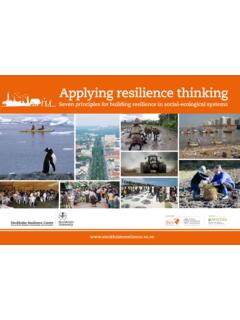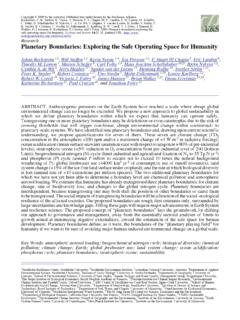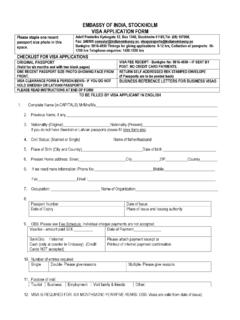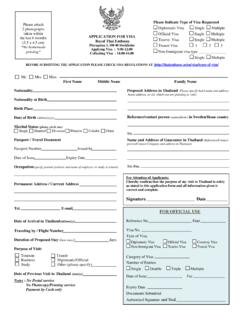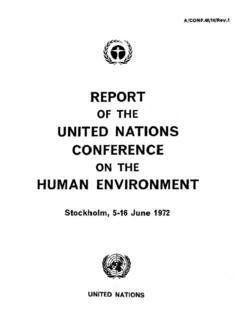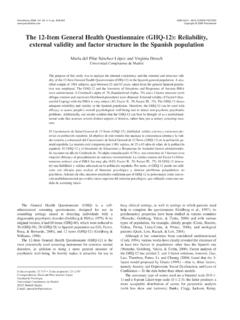Transcription of Planetary Boundaries: Exploring the Safe Operating Space ...
1 Copyright 2009 by the author(s). Published here under license by the Resilience Alliance. Rockstr m, J., W. Steffen, K. Noone, . Persson, F. S. Chapin, III, E. Lambin, T. M. Lenton, M. Scheffer, C. Folke, H. Schellnhuber, B. Nykvist, C. A. De Wit, T. Hughes, S. van der Leeuw, H. Rodhe, S. S rlin, P. K. Snyder, R. Costanza, U. Svedin, M. Falkenmark, L. Karlberg, R. W. Corell, V. J. Fabry, J. Hansen, B. Walker, D. Liverman, K. Richardson, P. Crutzen, and J. Foley. 2009. Planetary Boundaries: Exploring the safe Operating Space for humanity.
2 Ecology and Society 14(2): 32. [online] URL: http://www. Research Planetary boundaries : Exploring the Safe Operating Space for Humanity Johan Rockstr m 1,2, Will Steffen 1,3, Kevin Noone 1,4, sa Persson 1,2, F. Stuart III Chapin 5, Eric Lambin 6, Timothy M. Lenton 7, Marten Scheffer 8, Carl Folke 1,9, Hans Joachim Schellnhuber 10,11, Bj rn Nykvist 1,2, Cynthia A. de Wit 4, Terry Hughes 12, Sander van der Leeuw 13, Henning Rodhe 14, Sverker S rlin 1,15, Peter K. Snyder 16, Robert Costanza 1,17, Uno Svedin 1, Malin Falkenmark 1,18, Louise Karlberg 1,2, Robert W.
3 Corell 19, Victoria J. Fabry 20, James Hansen 21, Brian Walker 1,22, Diana Liverman 23,24, Katherine Richardson 25, Paul Crutzen 26, and Jonathan Foley 27. ABSTRACT. Anthropogenic pressures on the Earth System have reached a scale where abrupt global environmental change can no longer be excluded. We propose a new approach to global sustainability in which we define Planetary boundaries within which we expect that humanity can operate safely. Transgressing one or more Planetary boundaries may be deleterious or even catastrophic due to the risk of crossing thresholds that will trigger non-linear, abrupt environmental change within continental- to Planetary -scale systems.
4 We have identified nine Planetary boundaries and, drawing upon current scientific understanding, we propose quantifications for seven of them. These seven are climate change (CO2. concentration in the atmosphere <350 ppm and/or a maximum change of +1 W m-2 in radiative forcing);. ocean acidification (mean surface seawater saturation state with respect to aragonite 80% of pre-industrial levels); stratospheric ozone (<5% reduction in O3 concentration from pre-industrial level of 290 Dobson Units); biogeochemical nitrogen (N) cycle (limit industrial and agricultural fixation of N2 to 35 Tg N yr-1).
5 And phosphorus (P) cycle (annual P inflow to oceans not to exceed 10 times the natural background weathering of P); global freshwater use (<4000 km3 yr-1 of consumptive use of runoff resources); land system change (<15% of the ice-free land surface under cropland); and the rate at which biological diversity is lost (annual rate of <10 extinctions per million species). The two additional Planetary boundaries for which we have not yet been able to determine a boundary level are chemical pollution and atmospheric aerosol loading.
6 We estimate that humanity has already transgressed three Planetary boundaries : for climate change, rate of biodiversity loss, and changes to the global nitrogen cycle. Planetary boundaries are interdependent, because transgressing one may both shift the position of other boundaries or cause them to be transgressed. The social impacts of transgressing boundaries will be a function of the social ecological resilience of the affected societies. Our proposed boundaries are rough, first estimates only, surrounded by large uncertainties and knowledge gaps.
7 Filling these gaps will require major advancements in Earth System and resilience science. The proposed concept of Planetary boundaries lays the groundwork for shifting our approach to governance and management, away from the essentially sectoral analyses of limits to growth aimed at minimizing negative externalities, toward the estimation of the safe Space for human development. Planetary boundaries define, as it were, the boundaries of the Planetary playing field for humanity if we want to be sure of avoiding major human-induced environmental change on a global scale.
8 Key Words: atmospheric aerosol loading; biogeochemical nitrogen cycle; biological diversity; chemical pollution; climate change; Earth; global freshwater use; land system change; ocean acidification;. phosphorus cycle; Planetary boundaries ; stratospheric ozone; sustainability 1 2. Stockholm Resilience Centre, Stockholm University, Stockholm Environment Institute, 3 Australian National University, Australia, 4 Department of Applied 5 6. Environmental Science, Stockholm University, Institute of Arctic Biology, University of Alaska Fairbanks, Department of Geography, University of 7.
9 Louvain, School of Environmental Sciences, University of East Anglia, 8 Aquatic Ecology and Water Quality Management Group, Wageningen University, 9. Academy of Sciences, Potsdam Institute for Climate Impact Research,1311 Environmental 10. The Beijer Institute of Ecological Economics, Royal Swedish 12. Change Institute and Tyndall Centre, Oxford University,14 ARC Centre of Excellence for Coral Reef Studies, James Cook University, School of Human Evolution and Social Change, Arizona State 16 University, Department of Meteorology, Stockholm University, 15 Division of History of Science and 17.
10 Technology, Royal Institute of Technology, Department of Soil, Water, and Climate, University of Minnesota, Gund Institute for Ecological Economics, 18 19. University of Vermont, Stockholm International Water Institute, The H. John Heinz III Center for Science, Economics and the Environment, 20. Department23of Biological Sciences, California State University San Marcos, 21 NASA Goddard Institute for Space Studies, 22 CSIRO Sustainable 25. 24. Ecosystems, Environmental Change Institute, School of Geography and the Environment, Institute of the Environment, University of Arizona, Earth System Science Centre, University of Copenhagen, 26 Max Planck Institute for Chemistry, 27 Institute on the Environment, University of Minnesota Ecology and Society 14(2): 32.

